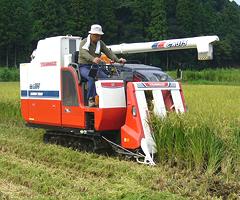 [Oryza sativa var japonica]
[Oryza sativa var japonica]
Rice is very expensive in Japan, and imports are restricted and heavily tariffed. This is to assure profitability of rice cultivation in Japan, as part of the country's Food Security Program. Rice is the only grain that can be grown in Japan in sufficient quantity. Nonetheless, Japan is the third largest market for rice grown in the United States, about 374,000 US Tons. Pretty much all is from California, where japonica rice is a specialty. Imports are 58% U.S. 39% Thailand and 1.7% Australia. Rice cultivation in Japan is highly mechanized. Photo by Katorisi distributed under license Creative Commons Attribution-ShareAlike v3.0 Unported.
General Information on Rice.
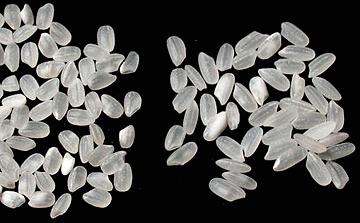 [Oryza sativa var japonica]
[Oryza sativa var japonica]
Uruchimai is Japan's regular rice, a Short Grain Japonica, grown in several cultivars. The photo shows Koshihikari to the left and California Calrose on the right. The Calrose is medium grain, longer than the Koshihikari. All rice grown in Japan is japonica, because it can withstand cooler climates than the long grain Indica.
Koshihikari is the most prestigious cultivar in Japan, though Akitakomachi is also well thought of. Sasanishiki is known for keeping the same taste when cooled down, so a preferred cultivar for Sushi. Yamada Nishiki is a cultivar grown specifically for sake. Oborozuki and Yumepirika are new cultivars that can stand colder weather and are now grown in Hokkaido, the large island in the far north of Japan. Koshihikari is actually a recent cultivar, developed in 1956.
Some Japanese rice is imported to North America, available on-line and
in California, but it's absurdly expensive, 2021 US $3.65 to $5.50 / pound.
Some Koshihikari type rice is grown in California, at about 2021 US $2.26
/ pound and higher, vs. $1.84 for Kokuho Rose.
Photo by Richardchoitt (condensed and cropped) distributed
under license Creative Commons
Attribution-ShareAlike v3.0 Unported.
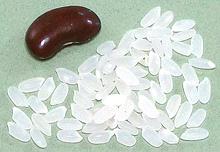
[Oryza sativa var japonica]
California rice, Calrose, Kokuho Rose, and others are medium grain
japonica rice cultivars developed by Japanese farmers for Japanese tastes,
and to be efficiently grown in California's Central Valley. This rice is
used by all Japanese restaurants and sushi bars in North America. The
Japanese consider it "inferior", but they import about 375,000 US Tons of
it every year. Japanese tourists heading home stop at the airport shops
to buy red, white, and blue bags of California rice, of the exact maximum
weight they are allowed to take back to Japan. The photo is of premium
quality Kokuho Rose medium grain rice developed by Koda Farms of South
Dos Palos, California, widely considered better than Calrose cultivars.
The photo specimens were typically 0.230 inch long and
0.105 inch wide (5.8 x 2.6 mm). For more details see our
California / Japanese Rice page.
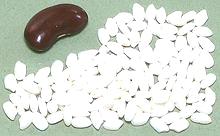
[Glutenous Rice; Mochigome (Japan)]
This intensely white short grain rice is the standard type for sweet
rice. Sweet rice is no sweeter than any other kind, but gets the name
from being used mainly to make sweets and deserts. It is very low in
amylose and very high in amylopectin starches, so it absorbs a lot of
water and cooks up very sticky (but it contains no gluten). The photo
specimens, grown in California, by Koda Farms, were 0.200 inches long by
0.107 inch wide (5.1 x 2.7 mm). A cup of this rice needs about 2-1/2 cups
of water and cooks in about 25 minutes.
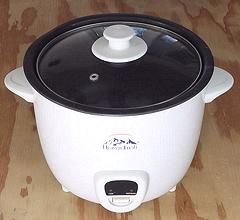 Nearly all Japanese households have an Electric Rice Cooker. Specialized rice
cookers have existed in Japan since the Edo era (1603 to 1867), but those
weren't electric and needed frequent attention. Rice cookers can be very
simple (see photo), to units with sophisticated computer controls. Some rice
cookers have a timed control so you can load them in the evening and they
will turn on in time to have fresh rice for breakfast. All modern versions
switch to "keep warm" when the rice is done. For details, see our
Rice Cooker page.
Nearly all Japanese households have an Electric Rice Cooker. Specialized rice
cookers have existed in Japan since the Edo era (1603 to 1867), but those
weren't electric and needed frequent attention. Rice cookers can be very
simple (see photo), to units with sophisticated computer controls. Some rice
cookers have a timed control so you can load them in the evening and they
will turn on in time to have fresh rice for breakfast. All modern versions
switch to "keep warm" when the rice is done. For details, see our
Rice Cooker page.
Before the rice cooker, the Japanese would wash the rice well, then soak
it for half an hour to a couple of hours depending on room temperature and age
of rice. This may still be done for the cooker, especially the wash step which
is always done. Then the rice would be boiled in a nearly equal amount of
water. When the water was absorbed and the rice partially cooked, it would
be steamed until cooked all they way through. Strangely, this is about the
same sequence used for Persian rice.